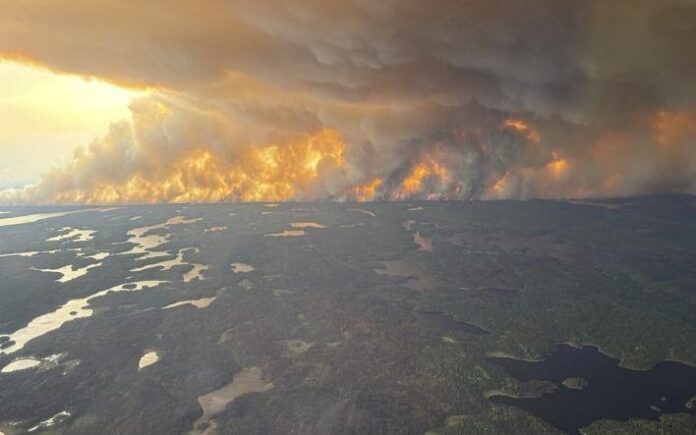Northern Manitoba is on fire, as can be seen in the above picture. The Premier describes thousands evacuating communities across the North. So far, 17,000 are displaced from this remote region of the province, and thousands more are expected to join them. Firefighters from across North America and members of the Canadian Armed Forces are joining the fight to try and contain the flames. To the south, The Pas and Winnipeg are filling up with climate-change-induced wildfire refugees. For First Nations communities that are isolated, the threat is even more extreme. If they cannot evacuate, the communities have lost power, freshwater access, fuel and are running out of food. What’s left is air evacuations.
Manitoba isn’t alone in facing drought-induced wildfires. Northern Saskatchewan is ablaze. Northern Alberta is on fire while parts of the interior of Northern British Columbia are facing similar conflagrations.
For climate change skeptics, wildfire is seen as a normal occurrence. The truth, however, is far different. These latest fires are a growing trend, and climate change is seen as the key driver.
How so? Climate change in the Western half of North America has led to higher temperatures and long dry spell periods, even droughts. As each above-normal warm season follows another, we are witnessing temperatures creeping upward. Parts of Manitoba and Saskatchewan have recently experienced temperatures 6.6 to 13.5 Celsius (11.8 to 24.3 Fahrenheit) higher than normal. Northern Manitoba recorded a daytime high of 33 degrees Celsius (over 91 degrees Fahrenheit) at the end of this month, an unprecedented temperature. Climatologists link this increased heat to climate change, stating it is five times more likely because of anthropogenically caused warming.
Warming temperatures increase evapotranspiration (accelerated evaporation and transpiration from forests, soil and other vegetation). The governments of Saskatchewan and Manitoba have currently defined conditions across the two provinces as abnormally dry or in moderate drought.
Weather isn’t the same as climate change, but its patterns certainly exacerbate the current conditions. The two provinces have been locked into the heat by a persistent high-pressure system that stalled over Central Canada, preventing rain and cooler temperatures from moving in. Along with the heat and lack of rain have come high winds to add to the wildfire threat. Add to this thunderstorms with no rain but lots of lightning, and the fire threat gets even worse.
As in California and other parts of the Southwestern United States, the wildfire season in Western Canada is coming earlier each year and lasting longer. These conditions reflect an overall drying out of the western half of North America while the eastern half is getting wetter.
The health consequences of these wildfires cannot be understated. The effect on people includes exposure to fine particulate matter, carbon monoxide, and volatile organic compounds that get inhaled, contributing to rising levels of asthma, bronchitis, COPD (Chronic Obstructive Pulmonary Disease), cardiovascular disease, including heart attacks and strokes, and premature deaths.
Other health effects from wildfire smoke include reproductive and developmental impacts, with low birth weights associated with exposure. As for mental health impacts, wildfires can be devastating, with depression and suicidal thoughts rising in populations exposed to them months and years later, a manifestation of PTSD (Post Traumatic Stress Disorder).
Humans aren’t the only life that suffer from wildfire smoke. Livestock and pets exhibit the same health effects. Wildlife isn’t just a victim of wildfire smoke. There is also the loss of habitat.
Other than reacting to these wildfire outbreaks, what can we do? Here are suggestions:
- Stop Fuelling the Beast – Wildfires occur naturally, but not to the extent we are experiencing today. Anthropogenic climate change is the reason. This is climate change caused by the increase in greenhouse gasses (GHGs) in the atmosphere. Rising GHGs raise daytime highs and nighttime lows. Higher temperatures disrupt the atmosphere’s water cycle and weather patterns. So, the first thing humans need to do is stop feeding the climate change beast.
- Develop New Land Management Strategies – Learn about wildfire prevention as practised by many Indigenous cultures for centuries to manage landscapes. Clear dead vegetation from forest floors. Do selective thinning of forests to create fire breaks. Rather than monoculture forestry replantings, plant a variety of trees that are more fire resistant.
- Change building codes to use fire-resistant materials – Construction materials for new builds and retrofits should meet a higher fire-resistance standard. Areas around buildings and homes should be planned to reduce fire risk.
- Don’t build homes and communities close to nature – Human encroachment into wildlife zones puts both people and wildlife at risk. The case example of the century is The Camp Fire, which in 2018, swept through the town of Paradise, California, killing 85 and destroying wildlife. The site of the town was nestled in the forests and foothills of the Sierra Nevada. Over 62,000 hectares (153,000 acres) were torched.
Various provinces operate their own FireSmart programs. FireSmart Canada is the national version that first started in 1993. It offers communities prone to wildfire threats, hazard assessment audits, mitigation plans, and teaches how to live with wildfire risk. Yet even with all the education, workshops and guidelines, humans remain unprepared when wildfires break out. Some stay and others flee. Every year there are needless deaths.
Climate change scientists talk about being a frog in a pot of water slowly being heated on a stovetop. The frog can jump out before the water gets too hot, or boil to death. Our wildfire experiences to date make it seem like we are no smarter than that boiled frog.








